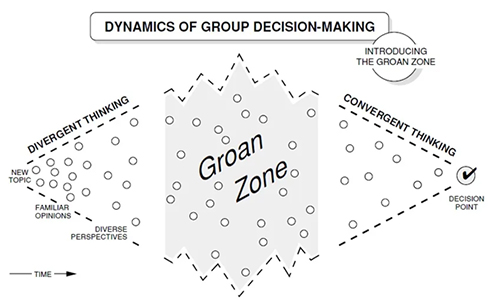Dec 13, 2023

Increasingly, organizations and companies see the value of having a thoughtful approach to making decisions. Making decisions in meetings can consume a lot of our time or they can be satisfying opportunities to learn from colleagues and accomplish meaningful work together.
Below are ten tips for decision-making done well.
- Figure out how important and urgent the decision is. Most of us live in a rushed work environment. Every decision has to be made as soon as possible. Let’s try another approach. Step away and check how important and urgent a decision really is, before rushing to make it.
- Consider a range of possible decision-making models. Any of the following options are perfectly valid, depending on the nature of the decision and people involved: single person decides, subgroup decides, majority votes, consensus is sought.
- When seeking consensus, define what you mean up front. For example, you might continue to explore and debate until everyone is fully supportive of the final decision, regardless of the time spent on the process. Or you might seek consensus for a defined period of time, after which another decision-making option gets used.
- Get clear on the current situation that calls for a decision. For example, if you’re going to decide on a new client survey form, make sure everyone involved is clear about the current form, how it’s been used, what is working and what challenges have been experienced with it.
- Include the right people in the process. It’s a problem when the only people charged with making a decision are doing so for political reasons, or by default. Think through who would be the best people to involve in the decision.
- Explain whether people are being invited to consult or decide. When you get people involved, let them know if you want them to be part of making the final decision (decide), or if you are inviting their opinion, suggestions and perspective (consult).
- Make all the data available and collect more, if necessary. Gather the available data to help inform a decision. If you’re stuck, you need more. Remember, data includes people’s fears, wishes, sense of security, etc. It is all data and all plays into a decision.
- Estimate when a decision will be made and let people know in advance. If a decision gets delayed for whatever reason, give people an update. When the decision is made, make sure everyone knows.
- Expect and embrace struggle. Sam Kaner, in his book, Facilitator’s Guide to Participatory Decision-Making (2014), offers a great model for recognizing the inevitable “groan zone” of decision-making processes. We prefer to call it the “growth” zone, and it can be challenging to navigate through.

- Check out some great resources on the topic including the Heath brothers’ book, Decisive: How to Make Better Choices in Life and Work (2013).
What tips do you have for good decision-making?
Valerie Uccellani is a Senior Partner with Global Learning Partners. Here are more blogs by Valerie.
Here are some additional resources that may interest you:
- Three Decision-Making Roles – a GLP video
- Three Decision-Making Roles – a GLP resource
- Participatory Decision-Making Technique: Dot-ocracy – a GLP blog
- Talking Circle: More Than a Technique – a GLP blog



